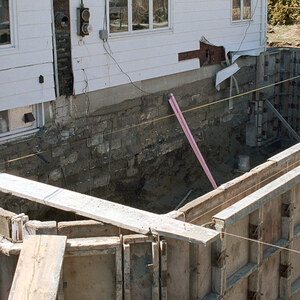I am working on replacing the trim on some 60’s vintage windows after the owner removed the existing trim as part of a face lift for his aging house. The exterior is wood clapboard siding and there are significant gaps between the existing single pane windows and the siding boards (~1/2 – 3/4″). The metal window trim is flush with the siding and it appears that there was no sealing around the old trim. I want to make sure that the windows/trim are waterproof without having to remove or cut into the siding (unless absolutely necessary) when I replace the trim with 2X resawn lumber. Is there a flashing/caulking approach that can ensure that the windows are watertight without doing major surgery on the siding?
Discussion Forum
Discussion Forum
Up Next
Video Shorts
Featured Story

The "She Build" initiative is empowering women in Seattle, WA by ensuring they have safe, healthy homes.
Highlights
"I have learned so much thanks to the searchable articles on the FHB website. I can confidently say that I expect to be a life-long subscriber." - M.K.

















Replies
You have few options without replacing the windows while you properly detail the openings.
With gaps of 1/2 to 3/4", one might be to cut back the siding enough to be able to lay in a perimeter metal flashing behind the siding, then go over that with vicor up to the metal frame (and over the window flange.
or the opposite, vicor first, then the metal. You'll have to hold the vicor back enough from the edge of the siding to be able to slip the metal in.
Start at the bottom and overlay everything uphill.
Then case out the perimeter of the window. Run the casing up to the siding, not over it.
That option assumes there's a flange on that window.
Don't forget to seal all the cuts on the siding and on your new trim.
Re-reading this post of yours, did he remove trim that layed over the siding? hence the gaps that now appear? If you repeat that technique it would be a mistake. Any waterproofing will rely only on the caulking detail.
Sorry for the disjointed nature of this post-one eye is on the next "snow event" approaching from the west.
If the clapboards are in good shape and not too fragile, you can either, gently pry the nails on the ends loose or slide a sawzall blade behind and cut them. Take the time to clean up and drive in or remove any protruding nail shanks. You should be able to slip some Vicor under the siding. Cut your new trim to fit to the siding. Re-nail in the same holes with the next size nail, caulk the trim/siding joint.
You can cut the siding in place to even things out if you have to. I temporarily attach a straight edge to the wall and use it as a guide for a router. If the clapboards are wider than the router base, you can make a larger base, make a stepped straight edge or use a template guide on the straight edge.